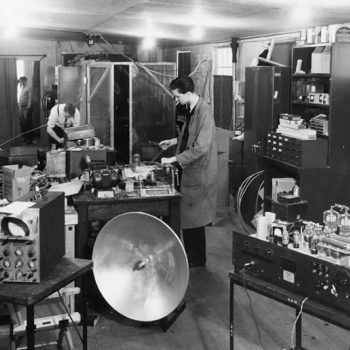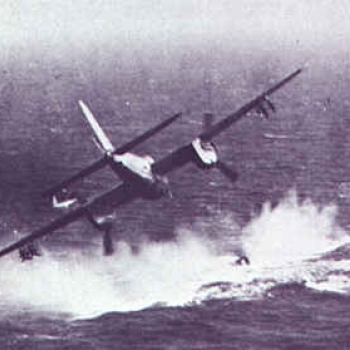
MIT Radiation Laboratory
The early signs of war in Europe in the late 1930s did not initially stir a significant response among the scientific and technical communities in the United States. However, by 1940, the premonition of impending war began to galvanize action.
In June of 1940, Vannevar Bush, the Scientific Advisor to President Franklin Roosevelt, along with Karl Compton, President of MIT, and James Conant, President of Harvard, presented to President Roosevelt a plan for a National Defense Research Committee to oversee scientific research directed toward the impending war effort, an idea that Roosevelt quickly approved. Compton headed up the section of the Council overseeing technologies for detection of aircraft and ships, capabilities that were sorely lacking at the time.
World War II Threats
German V-1 drone.*
|

German U-boat.**
|
World War II Impacts
Damage to London.
|

Allied tanker burning following U-boat attack.
|
The task was quickly narrowed to detection using microwaves, and Compton assigned the task to Alfred Loomis, a wealthy American with a private laboratory and an interest in microwave technology. Loomis's committee did a search of existing capabilities and found that, although microwaves could theoretically provide the detection ranges and accuracies needed to detect aircraft and ships, there were no microwave sources in the desired frequency range that were sufficiently powerful to do the job.
Meanwhile, because of the bombing of London, the British were ahead of the United States in the development of microwave technology. In September 1940, Great Britain sent a mission headed by Sir Henry Tizard to the United States. The British brought one of their most prized and highly guarded technical secrets, the 10 cm cavity magnetron. Loomis invited the British mission to meet with his Microwave Committee. Over a three-week period, the Committee, in conjunction with the British, laid out the basic structure of the program that would develop radar technology and have a decisive role in the Allied victory in World War II.
With the basic research program laid out, the Microwave Committee had to find a location for the research to be conducted. Compton was prevailed upon to host the new laboratory at MIT, but he was reluctant because of the impact he perceived it would have on the campus. However, he was eventually persuaded to do so by the members of the Committee.
The next job was to find leadership. Lee DuBridge, a nuclear physicist from the University of Rochester, was recruited to serve as the director of the new laboratory, and Isidor I. Rabi, a future Nobel laureate then in the physics department at Columbia University, was appointed associate director. The final task was staffing the new laboratory. Fortunately, that fall, MIT hosted an annual conference on applied nuclear physics. Attendees noticed that a great emphasis was placed on microwaves that year and that there were many private meetings. By the end of the conference, the core staffing for the laboratory had been signed up. The name Radiation Laboratory, or "Rad Lab," was chosen to be intentionally deceptive, creating the perception to those on the outside that the laboratory was working on nuclear physics, a discipline that was seen as too immature to have an impact on the war effort. During the fall of 1940, the Rad Lab sprang to life on the MIT campus, and by December, a primitive two-parabola system had already been emplaced and was undergoing initial testing on the rooftop of Building 6 at MIT.
During the next five years, the Radiation Laboratory made stunning contributions to the development of microwave radar technology in support of the war effort. Inventions included airborne bombing radars, shipboard search radars, harbor and coastal defense radars, gun-laying radars, ground-controlled approach radars for aircraft blind landing, interrogate-friend-or-foe beacon systems, and the long-range navigation (LORAN) system. Some of the most critical contributions of the Radiation Laboratory were the microwave early-warning (MEW) radars, which effectively nullified the V-1 threat to London, and air-to-surface vessel (ASV) radars, which turned the tide on the U-boat threat to Allied shipping. In November 1942, U-boats claimed 117 Allied ships. Less than a year later, in the two-month period of September to October 1943, only 9 Allied ships were sunk, while a total of 25 U-boats were destroyed by aircraft equipped with ASV radars (Buderi, pp. 155–169).

At its peak in 1945, the Rad Lab employed 3500 people and was spending close to $4 million a month. It developed over 100 radar systems, and its designs resulted in $1.5 billion of radar production in industry. In the words of Karl Compton, the Rad Lab was "the greatest cooperative research establishment in the history of the world" (Saad, p.47). It is frequently said that, although the atomic bomb ended World War II, it was radar that won the war.
The Rad Lab shut its doors on December 31, 1945, with most of its staff returning to academia. Lincoln Laboratory came into existence seven years later, in 1952, in response to a new threat that was then facing the nation. Much of the organizational and project management approach, as well as many of the initial employees of Lincoln Laboratory, came directly from the Rad Lab. The Rad Lab, and later, Lincoln Laboratory, are two examples of MIT leaning forward when called upon for the service of the nation.
* Photograph of German drone courtesy of www.zenza.se/vw.
** Photograph of German U-boat created by the United Kingdom government.



